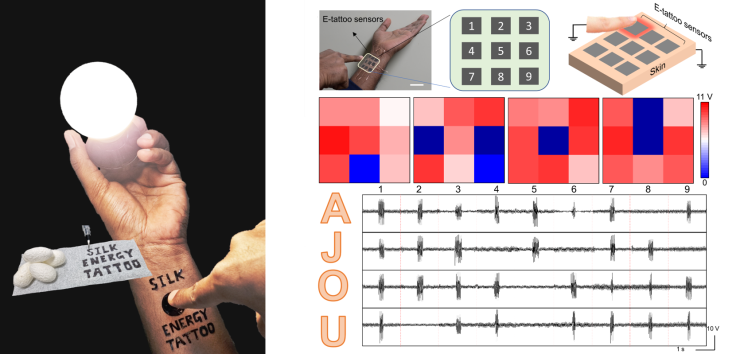- About Ajou
- Admission
- Academics
- Research
-
International
International
- Campus Life
-
News and Event
News and Event
- AUT
Ajou News
NEW Prof. Kim Sung-hwan Develops Self-powered Electronic Skin Generating Electric Energy
- 2021-07-01
- 6159

A team of researchers led by Prof. Kim Sung-hwan, from the Departments of Physics and Energy Systems Research, has developed electronic skin capable of generating energy with a touch using silk protein nanofibers. This development is expected to be used as a next-generation bio-electronic material, generating electric energy or acting as sensory organs upon attachment to the human skin or soft robots.
Prof. Kim announced successful development of electronic tattoos, which make it possible to draw circuits on silk protein nanofibers with carbon nanofiber ink using electrostatic-harvesting materials. Protein derived from silkworms is a skin-friendly, high-molecular biomaterial.
The achievement was published online under the title, “Self-powered and Imperceptible Electronic Tattoos based on Silk Protein Nanofiber and Carbon Nanotubes for Human-machine Interfaces,” in Advanced Energy Materials (Impact Factor 25.245), a prestigious international journal covering energy materials, on May 11. Prof. Narendar Gogurla, Research Assistant Professor, participated as first author and worked together with Prof. Kim.
There is a fast-growing body of research worldwide on materials for next-generation electronic healthcare devices for human-machine interfacing. Electrostatic-harvesting materials that leverage electrostaticity as an energy source are gaining more traction than ever. Electrostatic-harvesting materials can be used as a source of energy to move healthcare materials and artificial sensing organs that relay information related to human body movements.
However, in order to increase energy efficiency, compatible materials should be used (e.g. hair and plastic show ideal electrostaticity), serving as an obstacle to generating electric energy in direct contact with human skin. In addition, the fact that the materials should be attached to human skin, no matter how uneven, while being composed of elements harmless to the human body, makes it harder to accelerate outcomes for research on electrostatic-harvesting materials.
The team focused on silk proteins available from natural sources. Protein derived from silkworms is a skin-friendly, high-molecular biomaterial with superior physical and chemical properties.
In the first step, the researchers make silk nanofiber paper, of a thickness equivalent to one-fiftieth of a strand of human hair, using electrospinning. Afterwards, they draw circuits on the silk nanofiber paper using carbon nanofiber ink and brush. Once the ink dries, the drawn circuits come out. Placing the circuits on slightly moist skin creates the electronic tattoo.
The electronic tattoo is ultrathin, so it can be put on finely-wrinkled skin surfaces like finger pads while maintaining stability of its electric properties during everyday activities, besides taking showers. Electronic tattoos can easily be wiped off with wet wipes. Materials derived from silk nanofibers are harmless as the silk nanofibers are injected in the middle of the electronic tattoos.
Interestingly, electronic tattoos attached to the human skin have the highest efficiency, signifying that other materials, including disposable gloves, should be worn to increase the efficiency of electrostatic energy. The harvested electric energy is sufficient to operate small electronic devices, such as LEDs and stopwatches. The fact that electric signals are generated with a single touch means that the tattoos can be used as artificial sensing organs. The team successfully drew pixel tattoos on the skin, proving that drawn circuits are capable of being converted into electric signals with the touch of a finger.
Prof. Kim explained: “Although there has been significant progress in research on harvesting energy from the human body, the problems related to human-machine interfacing have been relatively neglected. Using proteins, of which natural skin is composed, interfaces capable of bridging the material difference between the human body and electronic devices can be developed.”
He also added: “Our project is significant in that our invention can help increase the application of biomaterials to a variety of electronic devices. We hope to see our product applied to a wide range of healthcare products and soft robotics in the future.”
The research was sponsored by the Rural Development Administration, the National Research Foundation of Korea, the BK21 FOUR, and the Gyeonggi-do Regional Research Center.
Description: (Left) A conceptual diagram of a silk, electrostatic electronic tattoo, able to collect electric energy with a single touch on the skin using biocompatible electronic tattoos.
(Right) An experiment on artificial sensing organs. Circuits drawn as pixel tattoos on the skin are capable of being converted into electric signals with the touch of a finger.
